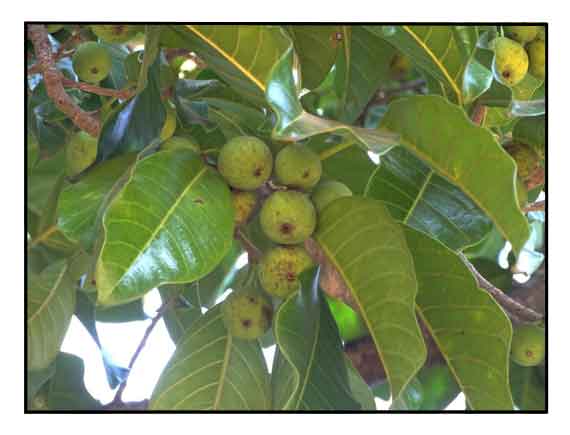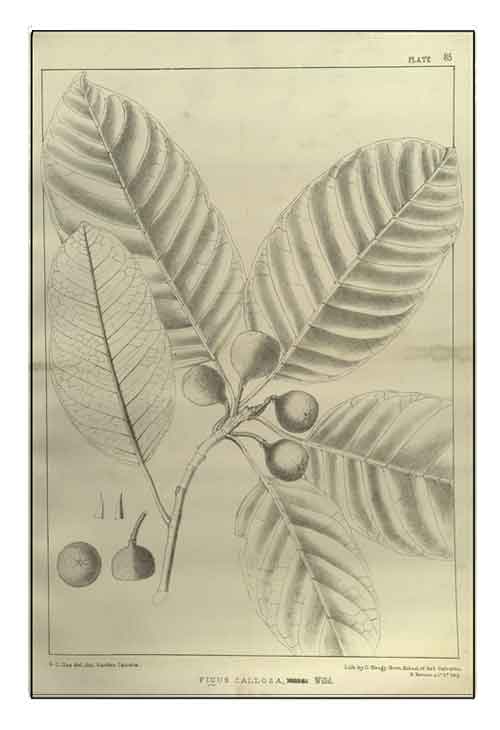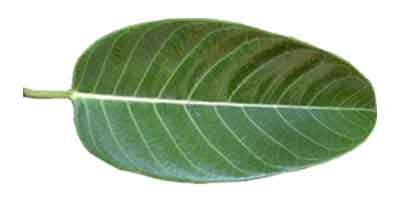 Gen info Gen info
- Ficus is a genus of about 850 species of woody trees, shrubs, vines, epiphytes and hemiepiphytes in the family Moraceae, many known as fig trees or figs.
-
Ficus callosa is an Asian species of fig tree in the family Moraceae.
Botany
Ficus callosa is a tree growing 25-35 m tall; trunk straight, d.b.h. 25-35 cm. Bark gray to pale gray, hard. Branchlets wrinkled when dry. Stipules ovate-lanceolate, 1-1.8 cm, pubescent. Petiole 3-9 cm; leaf blade broadly elliptic, 15-30 by 8-20 cm, leathery, abaxially pale green but graying green when dry, adaxially green, glabrous, and shiny, base rounded to broadly cuneate, margin entire, apex obtuse or mucronate; secondary vein 8-11 on each side of the midvein, prominent on both surfaces. Figs axillary on normal leafy stem, paired or solitary, yellow when mature, pear-shaped-ellipsoid, 1.2-2.5 by 1-1.5 cm, pubescent but glabrescent, base attenuate into a 1 cm stalk, apical pore flat; peduncle 1-1.2 cm; involucral bracts lanceolate-ovate ca. 2 mm. Male, gall and female flowers within same fig. Male flowers: near apical pore or scattered, thickly pedicellate; calyx lobes 3-5, spatulate; stamen 1 or 2; filaments thin, if stamen 1 then filament absent. Gall flowers: similar to female flowers but stigma very short. Female flowers: calyx deeply 3-5 lobed, broadly lanceolate; style lateral; stigma deeply 2-branched. (Flora of China@efloras.org) (3)
 Distribution Distribution
- Native to the Philippines.
- Also native to Andaman Is., Bangladesh, Borneo, Cambodia, China, India, Jawa, Laos, Lesser Sunda Is., Malaya, Maluku, Sri Lanka, Sulawesi, Sumatera, Thailand, Vietnam.
(2)
Constituents
- Study of methanol extract of Ficus callosa leaves by repeated column chromatography isolated one new megastigmane glycoside, ficalloside (1) and eleven known compounds: linarionoside A (2), corchoionoside C (3), (7R,8S)-dihydro-dehydrodiconiferyl alcohol (4), glochidioboside (5), syringaresinol-ß-D-glucoside (6), styraxlignolide E (7), (1'R,2'R)-guaiacyl glycerol (8), tricin (9), glucotricin (10), luteolin (11) and rhoifolin (12). (see study below) (5)
Properties
Studies have suggested antioxidant properties.
Parts used
Leaves, stem bark.
Uses
 Edibility Edibility
- In southwest China, the young edible leaves are traditional consumed by local people in Xishuangbanna. (7)
Folkloric
- No reported folkloric medicinal use in the Philippines.
- In Indonesia, the Tetun ethnic people of West Timor use the stem bark for treatment of malaria. (6)
- In Java, used for treatment of acne.
Others
- Wood: In the Visayas, prized for its lightness and resistance to marine borer, which make it ideal for boat making. Its nearly cylindrical bole and fast growth provides potential as material for electrical posts. May be used for light construction of sash door, panel cores, pulp and paper making, wall board, pencil slat, matchstick, musical instruments -- a potential livelihood for coastal communities. (8)
Studies
• Antioxidant / Leaves: Study of methanol extract of Ficus callosa leaves by repeated column chromatography isolated one new megastigmane glycoside, ficalloside (1) and eleven known compounds. Antioxidant activities of the compounds were measured by ORAC assay. Compound 8 exhibited potent antioxidant activity of 10.6 micoM trolox equivalents at concentration of 2 microM. At this concentration compounds 4-7 and 9-12 showed significant antioxidant activity ranging from 2.1-6.1 microM trolox. (see constituents above) (5)
• Antioxidant / Leaves: Study of evaluated the young leaves of seven Ficus species traditionally consumed by local people in Xishuangbanna. Results showed the edible young leaves of the seven Ficus species possess abundant antioxidants at various concentrations. F. callosa extract showed substantial inhibition against peroxidation of linoleic acid. (7)
Availability
Wild-crafted.
|

![]()



 Gen info
Gen info Distribution
Distribution Edibility
Edibility